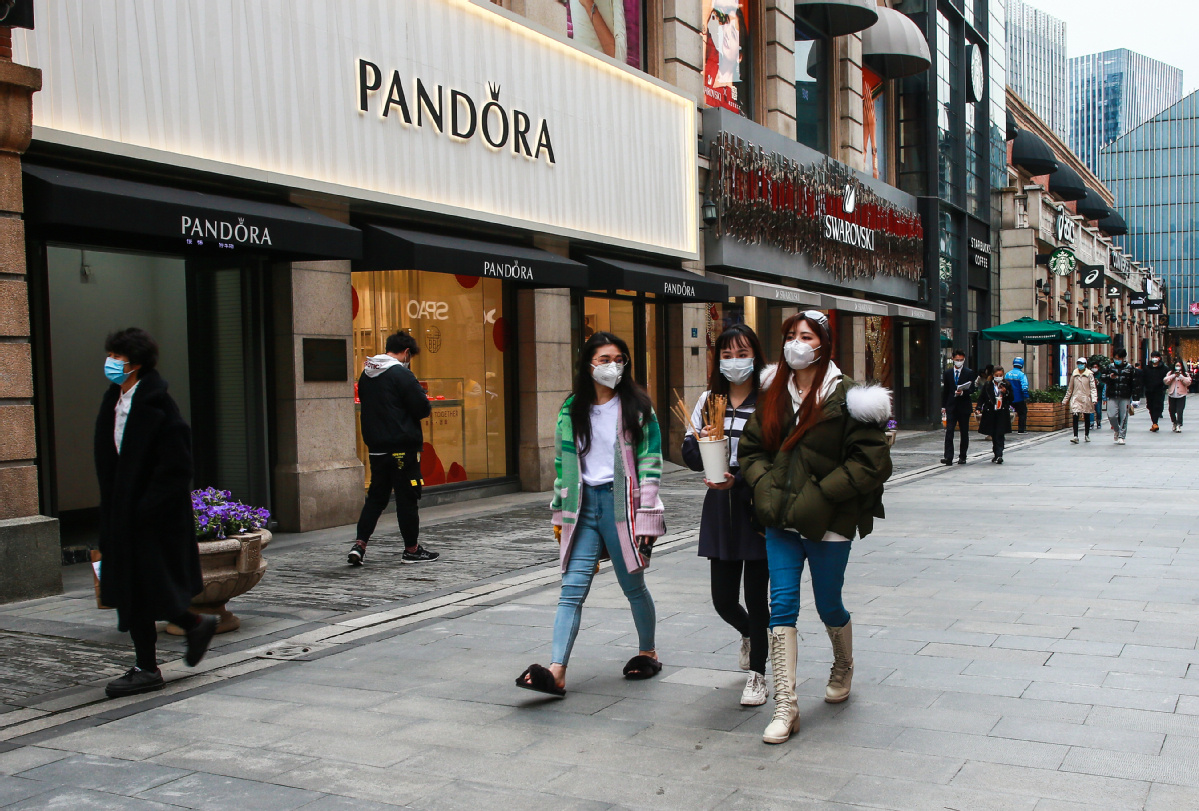
Pedestrians pass by a jewelry store on the Han Street of Wuhan, capital of Central China's Hubei province, on March 30. [Provided to China Daily]
Chinese consumers will continue to drive global luxury purchases, buying nearly 50 percent of luxury goods worldwide by 2025 as the country has been leading the global recovery of the COVID-19-hit high-end products' market, said an industry report.
According to the latest Luxury Goods Worldwide Market Study, produced by research firm Bain & Co in collaboration with Italian luxury industry monitor Fondazione Altagamma, the global luxury market will reach 320-330 billion euros ($354-365 billion) in 2023 thanks in large part to Chinese consumers, online channels and young customers.
Chinese consumers will make up around half of luxury purchases globally by 2025, compared with 35 percent in 2019. Luxury purchases made within China itself will take up 28 percent globally in 2025 than 11 percent in 2019.
The report found that in the fourth quarter of last year, luxury spending in China accelerated and then started strong this year, but was soon hit by traffic restrictions and lockdowns due to the epidemic.
After months of store closures and social distancing, Chinese consumers will likely show a willingness to make pent-up purchases put off during the first several months of the year.
Continued travel restrictions mean that many purchases that would have been made abroad will instead take place in China, said the report.
Globally, following a positive final quarter of 2019 and a very promising start to 2020, the personal luxury goods industry was hit hard by the coronavirus crisis, consequent national lockdowns and air traffic restrictions, with a negative impact witnessed across all product categories and all markets for the current year, said the report.
Matteo Lunelli, president of Altagamma, said: "The pandemic had an immediate impact on the luxury goods industry worldwide, and it will lead to a 20 percent fall in turnover in 2020. The industry will get back on its feet, however, and the long-term trend remains positive-Altagamma Bain Monitor on World Markets estimates a growth of 2-3 percent between now and 2025."
He said the Italian creative industry, with its unique manufacturing, creative and entrepreneurial resources, has the credentials to recover and return to its leading role.
In the short term, the aim is to safeguard struggling supply chains. In the medium term, the objective is to work on digital transformation, relaunch tourism and ensure there is an even stronger focus on environmental and social sustainability, Lunelli said.
The report estimates an average decrease of 20 percent in the consumption of personal luxury goods globally in 2020.
By region, that means a 29 percent decrease in Europe and a 22 percent drop in the Americas in terms of luxury consumption can be expected due to the regions' longer exposure to the crisis and lack of international tourist flows, especially from China.
Spending by Chinese consumers (down 9 percent, the first region to come out of the crisis), Japanese consumers (down 14 percent) and the rest of Asia (down 16.5 percent) is expected to drop sharply in 2020, albeit to a lesser extent than European and North American consumers (down 25 percent and 21 percent, respectively).
In terms of product categories, the hardest hit are expected to be jewelry, down by 23 percent, watches, by 25 percent and clothing, by 21.5 percent.
The report predicts a sharp decrease in world consumption, with profits among companies in the luxury sector down 30 percent in 2020.
One very positive sign is the performance of online channels, with 2020 retail seen up 16 percent and wholesale up 12 percent.
Companies will certainly be boosting their digital transformation, and the crisis will lead to new lifestyle trends, with consumers prioritizing sustainability and embracing moderation and conscientiousness, said the report.
The report estimates that global consumption of personal luxury goods dropped by 25 percent in the first quarter, compared to the same period of 2019.
Looking beyond 2020, the evolution of the global market will be based on four key drivers: regional macrotrends, local consumer confidence, tourist flows and strategies proactively taken by individual brands.
A return to the levels of 2019 is expected by 2022 or 2023, with different possible growth trajectories in the coming years depending on how the main market drivers develop, including brands' strategic responses to the crisis.
"We expect the luxury market to recover, but the sector will be profoundly transformed," said Claudia D'Arpizio, partner at Bain & Co and author of the study.
"The current crisis requires this industry to think even more creatively and to innovate even faster to meet consumer demand and work around the restrictions on the various channels. The brands that will come out on top are those that best manage to interpret the zeitgeist, while staying true to their DNA and roots."
Federica Levato, partner of Bain & Co and co-author of the study, said: "Consumers are seeing a world that has changed profoundly, and luxury brands will necessarily have to adapt. Safety in stores will be mandatory, and will have to be guaranteed while still offering the magic of the luxury shopping experience that develops creative ways to attract consumers to stores, or bring products directly to them. This is what will make the difference."


